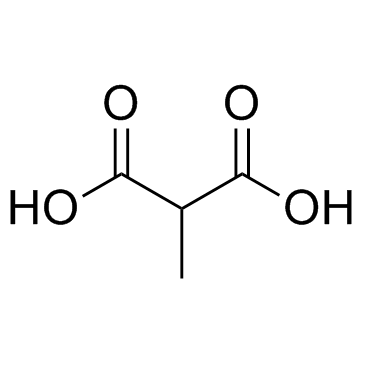516-05-2
| Name | ethylmalonic acid |
|---|---|
| Synonyms |
Methylmalonic acid
Propanedioic acid, 2-methyl- Methylpropanedioic acid EINECS 208-219-5 2-Methylmalonic acid methyl-Propanedioic acid 2-Methylpropanedioic acid MFCD00002656 methyl-Malonic acid 2-Methyl1-malonic acid Methylmalonate |
| Description | Methylmalonate is an indicator of Vitamin B-12 deficiency in cancer. |
|---|---|
| Related Catalog | |
| Target |
Human Endogenous Metabolite |
| In Vitro | Vitamin B-12 is required for Methylmalonate (Methylmalonic acid; MMA) to be converted to succinyl-CoA, and in combination with folic acid, for homocysteine (HC) to be converted to methionine. Therefore, Methylmalonate is clearly more specific to vitamin B-12 deficiency compared to HC[1]. |
| References |
| Density | 1.45 |
|---|---|
| Boiling Point | 334.4±25.0 °C at 760 mmHg |
| Melting Point | 129-136 ºC |
| Molecular Formula | C4H6O4 |
| Molecular Weight | 118.088 |
| Flash Point | 170.2±19.7 °C |
| Exact Mass | 118.026611 |
| PSA | 74.60000 |
| LogP | -0.21 |
| Vapour Pressure | 0.0±1.5 mmHg at 25°C |
| Index of Refraction | 1.474 |
| Storage condition | ?20°C |
| Water Solubility | soluble |
CHEMICAL IDENTIFICATION
HEALTH HAZARD DATAACUTE TOXICITY DATA
|
| Symbol |

GHS07 |
|---|---|
| Signal Word | Warning |
| Hazard Statements | H315-H319-H335 |
| Precautionary Statements | P261-P305 + P351 + P338 |
| Personal Protective Equipment | dust mask type N95 (US);Eyeshields;Gloves |
| Hazard Codes | Xi:Irritant; |
| Risk Phrases | R36/37/38 |
| Safety Phrases | S26 |
| RIDADR | NONH for all modes of transport |
| WGK Germany | 3 |
| RTECS | OO1400000 |
| HS Code | 2917190090 |
| HS Code | 2917190090 |
|---|---|
| Summary | 2917190090 acyclic polycarboxylic acids, their anhydrides, halides, peroxides, peroxyacids and their derivatives VAT:17.0% Tax rebate rate:9.0% Supervision conditions:none MFN tariff:6.5% General tariff:30.0% |

